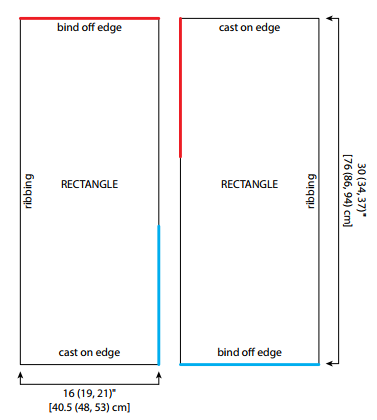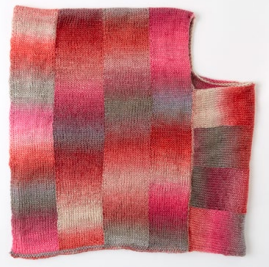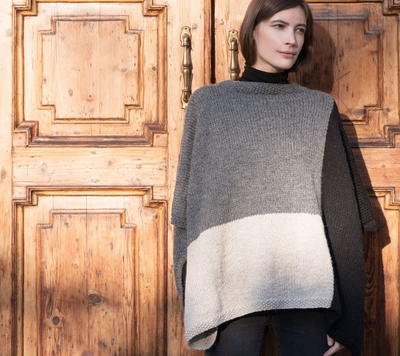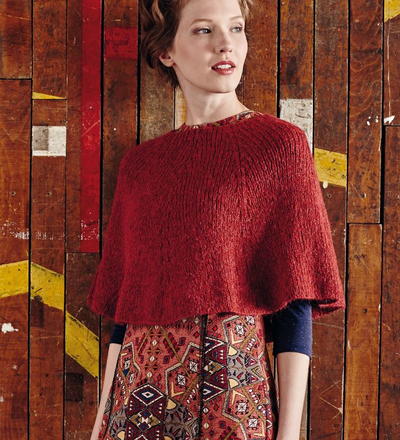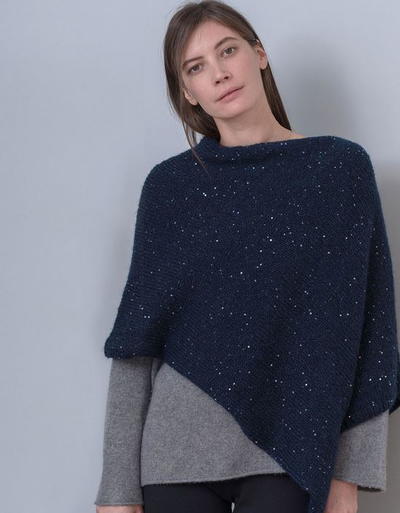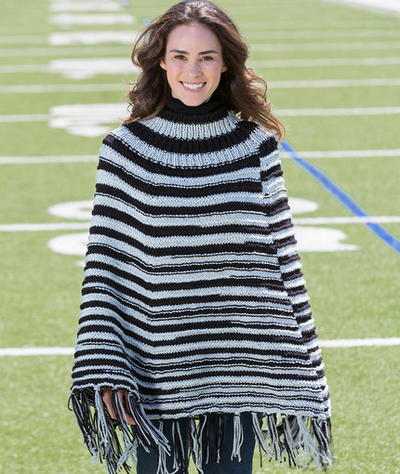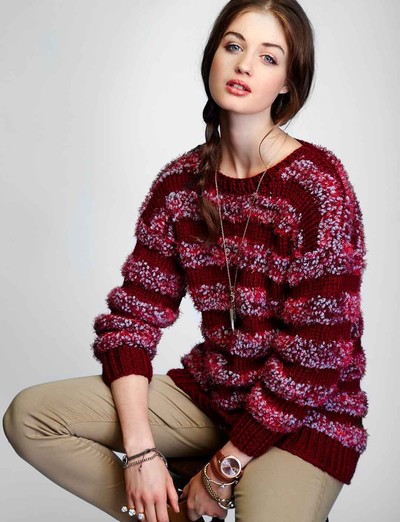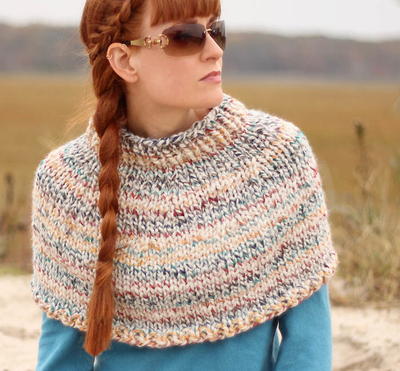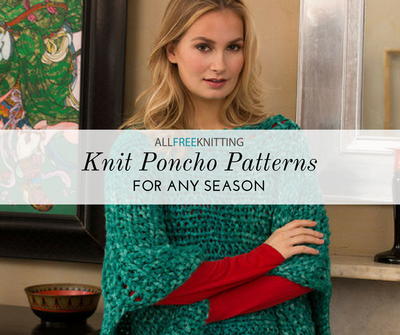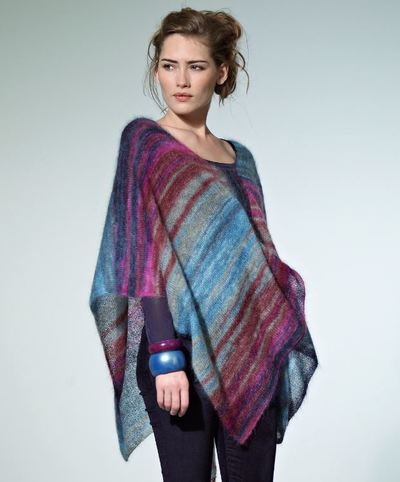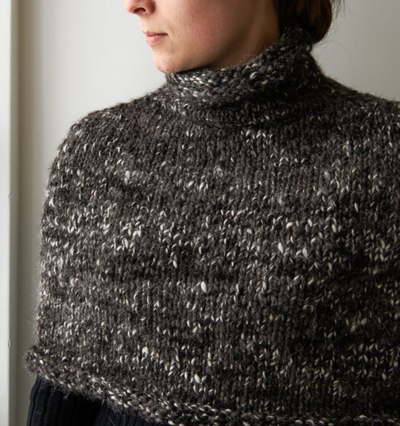Bargello Easy Poncho Pattern
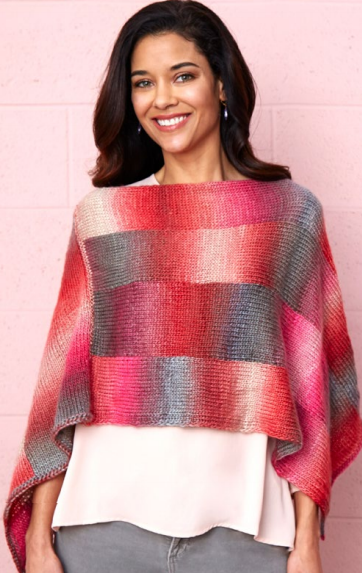
The Bargello Easy Poncho Pattern is a fun and easy way to add a little excitement to any outfit. This poncho is made using two simple rectangles sewn together. As a bargello pattern, this knit poncho uses a variegated yarn in offset strips to create a vibrant, multicolored design. This knit poncho pattern is cute when worn with the Vs in front or to the side, which makes it a versatile addition to your chilly weather wardrobe. This pattern will not steer you wrong, and you will be wearing it for years to come!
NotesDirections are for size Small. Changes for sizes Medium/Large, and 2X-Large/ 3X-Large are in parentheses. Note that directions do not include an X-Large size. If X-Large size is needed, choose between Medium/Large and 2X-Large/3X-Large.
To Fit Bust: 32–34 (38–42, 50–54)" [81.5–86.5 (96.5–107, 127–137) cm] Each rectangle measures about 16 (19, 21)" [40.5 (48.5, 53.5) cm] wide and 30 (34, 37)" [76 (86.5, 94) cm] long, after blocking.

Knitting Needle Size8 or 5 mm
Yarn Weight(4) Medium Weight/Worsted Weight and Aran (16-20 stitches to 4 inches)
Gauge19 sts = 4" [10 cm]; 23 rows = 4" [10 cm] in Stockinette stitch (knit on right side, purl on wrong side).
Materials List
- RED HEART® Unforgettable®: 4 (4, 5) balls 3939 Heirloom
- Susan Bates® Knitting Needles: 5mm [US 8]
- Susan Bates® Crochet Hook: 5mm [US H-8]
- 3 (3, 4) stitch markers
- 4 (4, 5) zip-closure plastic baggies
- 1 zip-closure plastic baggie large enough to hold all the balls of yarn in smaller baggies
- permanent marker
- yarn needle
This free eBook will have you making perfect shawls for chilly weather!Cozy Free Shawl Patterns: 7 Knitted Shawl Patterns Perfect for Fall Free eBook
Instructions
NOTES
1. Poncho is made from two identical rectangles that are sewn together. Each rectangle is worked back and forth in rows changing color to make 4 (4, 5) intarsia columns.
2. When changing yarn, always pick up the new yarn from under the yarn being dropped to link the yarns and prevent holes.
3. Before beginning, examine the starting colors of each ball of yarn. Make sure that each ball starts on a different color. Winding off a few yards may be needed to ensure that the starting colors are all different.
4. To minimize tangling, place each ball into its own zip-closure plastic baggie with the end of yarn hanging out and the baggie zipped almost all the way closed. With permanent marker, label each baggie with one of A, B, C, and D for sizes Small and Medium/Large. Label each baggie with one of A, B, C, D, and E for size 2X-Large/3X-Large.
Rectangle (make 2)
With A, cast on 76 (84, 94) sts. Knit 2 rows.
-
Sizes Small and Medium/Large Only:
Set-Up Row 1 (right side): Slip 1, k18 (20), drop A, place marker; join B and k18 (20), drop B, place marker; join C and k18 (20), drop C, place marker; join D and k16 (18), p1, k1, p1, k2. -
Size 2X-Large/3X-Large Only:
Set-Up Row 1 (right side): Slip 1, k18, drop A, place marker; join B and k18 drop B, place marker; join C and k18, drop C, place marker; join D and k18, drop D, place marker; join E and k16, p1, k1, p1, k2. -
All Sizes:
Set-Up Row 2 (wrong side): Working each intarsia section with its own yarn and linking yarns to prevent holes (see note 2), slip 1, [p1, k1] twice, purl to end of row. -
Place all the bagged yarns into the larger zip-closure baggie. Placing the yarns in the larger baggie ensures that for the duration of the project it will not be necessary to reposition the yarn balls as you work. The yarns will link with each other while working a right side row then unlink themselves after completing the following wrong side row. If you notice that this is not happening and the yarns are tangled, check your work to see if a single yarn was used across more than one intarsia column. If this is the case, undo your work to the point where this occurred. Continue to work each intarsia section with its own yarn and link yarns to prevent holes, as you work all remaining rows of rectangle.
-
Next Row (right side): Slip 1, knit to last 5 sts, p1, k1, p1, k2.
-
Next Row (wrong side): Slip 1, [p1, k1] twice, purl to end of row.
-
Repeat last 2 rows until rectangle measure about 30 (34, 37)" [76 (86.5, 94) cm] from beginning, end with a wrong side row.
-
Cut all yarns except A .
-
With A only, knit 2 rows.
-
Bind off.
Finishing
-
Block rectangles to measurements shown on schematic.
-
Sew rectangles together where indicated on schematic, sewing red line to red line and blue line to blue line.
-
Neck Edging
With right side facing, crochet hook and most plentiful remaining ball of yarn, join with slip st anywhere in next edge, chain 1, single crochet evenly spaced around neck edge; join with slip st in first single crochet. Fasten off. Weave in ends.
Abbreviations
- A, B, C, etc.
- Yarn A, Yarn B, Yarn C, etc
- k
- knit
- p
- purl
- st(s)
- stitch(es)
- [ ]
- work directions in brackets the number of times specified
What's your favorite thing to knit for chilly weather?
Read NextFog Chaser Knit Cape
Your Recently Viewed Projects
Lisa
Dec 14, 2020
Really confused, the materials list specifies one yarn and one yarn color, but the directions instruct you to change colors? All of the unforgettable yarn is multi colored, so the instructions to change from yarn A-E seem incorrect.
Ingrid the Knitter
Dec 17, 2020
Firstly, you need to understand what Bargello is, it is taking set of squares of fabric of the same colour or tone, laying them side by side and moving the square up or down by one to get a gradient pattern. With this said, this poncho is knit using the same gradient yarn, but you need to wind it into separate smaller balls and using the Intarsia technique you are going to be knitting it as one piece, but with 5 different balls of the that yarn making it so you are knitting each section as a square of colour. I hope this explanation helps.
Lisa
Dec 21, 2020
Thank you so much for your reply, I did try to figure it out myself and had looked up the definition of bargello, but that said it-a needlework stitch that produces a zigzag pattern, to call this an easy patterns seems a bit ridiculous, with the intarsia and separating all the yarn, I can see many knitters getting into quite a mess with this pattern. I've worked with unforgettable yarn before and the color changes are not quite as defined as in a striping yarn, which would seem more effective for this type of project, seems like it is reliant on color pooling, which I've never found really effective in knitting.
Report Inappropriate Comment
Are you sure you would like to report this comment? It will be flagged for our moderators to take action.
Thank you for taking the time to improve the content on our site.


